Edgar Rice Burroughs’s Mars, Part 9: Synthetic Men of Mars
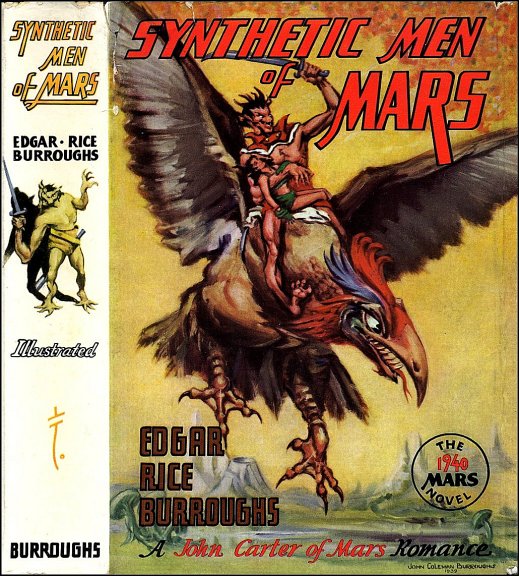 Greetings, late 1930s ERB! How have you been? Oh, not that great? Yes, I know how it is. I’ve read enough of your output from these days.
Greetings, late 1930s ERB! How have you been? Oh, not that great? Yes, I know how it is. I’ve read enough of your output from these days.
In this long trip across Burroughs’s Mars, I have now reached the conclusion of Phase #3 of the Barsoom books, with the last work of the 1930s. Synthetic Men of Mars is also the last novel Edgar Rice Burroughs wrote in the series. He turned to novellas after this, resulting in two collections, one posthumous. So the ninth book of Barsoom is a eulogy of sorts.
And “eulogy” is the appropriate word: let’s pause to remember the good times, because the good times are gone.
Our Saga: The adventures of Earthman John Carter, his progeny, and sundry other natives and visitors, on the planet Mars, known to its inhabitants as Barsoom. A dry and slowly dying world, Barsoom contains four different human civilizations, one non-human one, a scattering of science among swashbuckling, and a plethora of religions, mystery cities, and strange beasts. The series spans 1912 to 1964 with nine novels, one volume of linked novellas, and two unrelated novellas.
Today’s Installment: Synthetic Men of Mars (1939)
Previous Installments: A Princess of Mars (1912), The Gods of Mars (1913), The Warlord of Mars (191314), Thuvia, Maid of Mars (1916), The Chessmen of Mars (1922), The Master Mind of Mars (1927), A Fighting Man of Mars (1930), Swords of Mars (1934–35)
The Backstory
Edgar Rice Burroughs wrote Synthetic Men of Mars in 1938, soon after Carson of Venus and a potboiler Tarzan adventure, Tarzan and the Forbidden City, and right before the dreadful Pellucidar installment, Land of Terror. This wasn’t one of ERB’s stellar periods — and he was aware of it. Even though Tarzan was a success on film and in newspaper strips, Tarzan’s creator struggled for the first time to get his new stories sold. Every magazine turned down Land of Terror and the novel had to skip serial appearance and go straight to self-publication. Burroughs’s numerous attempts to sell non-Tarzan projects to Hollywood went nowhere. And although Synthetic Men of Mars sold to Argosy, a top magazine, Burroughs received only $1,200 for it, half of what the publisher paid for Carson of Venus and a seventh what he received for A Fighting Man of Mars eight years earlier. ERB’s gloomy attitude toward his work had disturbing real-world correlations.
Synthetic Men of Mars was written over a relatively prolonged period for its author: March to August of 1938. It first appeared in Argosy in six weekly installments from January to February 1939. ERB, Inc. put out the hardback a year later. The author’s son, John Coleman Burroughs, had now taken over art duties for all his father’s books, and provided five interiors for Synthetic Men along with its color cover.
The Story
A brief prologue reminds the readers of mad scientist Ras Thavas and explains that this new story comes from Vor Daj, a padwar of Helium and a companion to the Warlord, John Carter. Vor Daj dictated the tale to Vad Varo (Earthman Ulysses Paxton) to translate into English and then transmit via the Gridley Wave to pseudo-ERB in California.
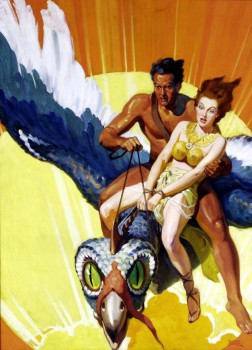 The story proper begins with the action already underway: John Carter and Vor Daj are searching for the scientist Ras Thavas (the titular Master Mind of Mars) in hopes he’ll know a way to save Dejah Thoris from injuries sustained in a barely explained accident. Carter and Vor Daj land in Phundahl, where a group of bizarre humanoids, capable of fighting even when their limbs get hacked off, capture them and take them to their city of Morbus in the middle of a swamp. These creatures are hormads, the synthetic men of the title, who were vat-grown from Ras Thavas’s experiments. The hormads seized control from their creator and now rule the city, with plans to produce enough of themselves to overrun Mars.
The story proper begins with the action already underway: John Carter and Vor Daj are searching for the scientist Ras Thavas (the titular Master Mind of Mars) in hopes he’ll know a way to save Dejah Thoris from injuries sustained in a barely explained accident. Carter and Vor Daj land in Phundahl, where a group of bizarre humanoids, capable of fighting even when their limbs get hacked off, capture them and take them to their city of Morbus in the middle of a swamp. These creatures are hormads, the synthetic men of the title, who were vat-grown from Ras Thavas’s experiments. The hormads seized control from their creator and now rule the city, with plans to produce enough of themselves to overrun Mars.
Captive along with Carter and Vor Daj is the beautiful Janai of Amhor. Vor Daj, of course, immediately falls in love with her. But she is separated from them when they are assigned to watch over Ras Thavas. The Martian scientist begins planning with the two heroes to escape from Morbus. Vor Daj asks to have his mind placed into the empty body of one of the deformed hormads, Tor-du-bar. In this guise, he gains service to the seven hormad jeds who rule the city.
One of the jeds, Ay-mad, proclaims himself jeddak and rebels against the other six. In the body of the hormad, Vor Daj fights on Ay-mad’s side and helps him seize the city. During the fight, Ras Thavas vanishes — and he’s the only hope Vor Daj has of getting his original body back. He tricks Ay-mad into giving Janai to him as a slave. Janai doesn’t know that the hideous hormad is actually Vor Daj; but she believes he is working for Vor Daj to protect her.
Vor Daj makes a terrible discovery in the lab: John Carter is missing as well. Also, there’s a growing mass of mindless hormad tissue that’s rapidly increasing in size and might threaten all of Mars!
Vor Daj’s adventures continue as he searches for and tries to protect his original body, escapes and re-enters Morbus a number of times, loses and regains Janai the same number of times (I think, it’s hard to keep track), meets the marsupial people of Gooli, and falls into the clutches of a fleet from Janai’s home city of Amhor.
Somebody also needs to do something about that massive, planet-consuming flesh blob, should they ever find time to schedule it.
The Positives
In his nonfiction study, Edgar Rice Burroughs: Master of Adventure, Richard A. Lupoff offers this single sentence review: “Synthetic Men of Mars has little to recommend it.”
Ouch. But Lupoff is too quick to damn this novel, because I located a few things to recommend the ninth book of the series. Despite its reputation as one of the worst Barsoom novels, Synthetic Men of Mars is still superior to most of the Venus books and the coeval Land of Terror.
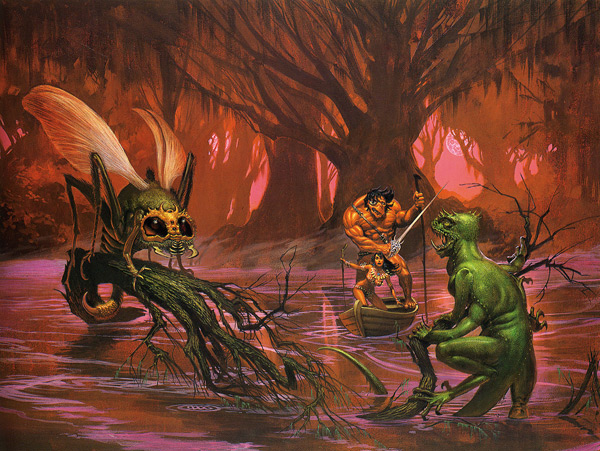 Face it, the title Synthetic Men of Mars gets us readers excited. And the hormads are a great, horror-filled idea. ERB puts some his best prose to use to make them grotesque and express the variety of their appearance. The flesh-blob monster (commonly referred to as “the mass in Vat Room 4”) is appropriately sickening, something H. P. Lovecraft would recognize as a relative of a shoggoth.
Face it, the title Synthetic Men of Mars gets us readers excited. And the hormads are a great, horror-filled idea. ERB puts some his best prose to use to make them grotesque and express the variety of their appearance. The flesh-blob monster (commonly referred to as “the mass in Vat Room 4”) is appropriately sickening, something H. P. Lovecraft would recognize as a relative of a shoggoth.
In fact, the book is filled with plenty of great ideas. The brain switch that places a human mind inside a bizarre inhuman body works better here than in The Master Mind of Mars, where almost nothing was made of a red Martian brain put in a white ape’s head. At least Vor Daj is our POV character and has perspective on what it’s like suddenly to have a deformed but abnormally strong body.
Ras Thavas is fun in his small portions at the beginning. Burroughs has a good grip on the character’s “rational madman” persona: a dangerous figure, but one whose science is admirably accurate. He also gives Ras Thavas the best lines and speeches. While touring his vats, Ras Thavas provides a pleasant diversionary lecture that fills in the biological background of Barsoom that harkens to the glory days of The Gods of Mars. It’s an important hunk of Barsoomian data.
John Carter’s return to prominence worked adequately in Swords of Mars, but most of what clicked in that book had nothing to do with its hero. Synthetic Men of Mars shows that Burroughs was aware of the problem but still could not release John Carter or first person, so he created Vor Daj as the Warlord’s sidekick who then becomes the main hero. This is a better solution than staying with John Carter’s view past its usefulness.
But John Carter gives the book one of its few poetic passages, a spot where ERB reclaims a touch of his magic from the early years. While talking with Vor Daj over the marsh around Morbus — a remnant of the seas that once covered the planet — the Warlord ponders the ends of both Earth and Mars, and observed that both worlds are dying. “The last of the great oceans … Its eventual passing will doubtless mark the passing of a world, and Mars will hurtle on through all eternity peopled by not even a memory of its past grandeur.”
Unlike many other bickering Burroughs couples, the romantic obstacle between Janai and Vor Daj makes sense: he’s in a horribly twisted body that she couldn’t love even if she knew his mind was in it. He chooses not to tell her what happened and lets her think he’s the hormad Tor-dur-bar, which is unrealistic, but otherwise this is an imaginative conflict in a place where Burroughs was usually unimaginative. ERB even works out a convincing psychological wrap-up for the two. And Janai isn’t revealed as a secret princess at the end! Hooray for a commoner marriage!
T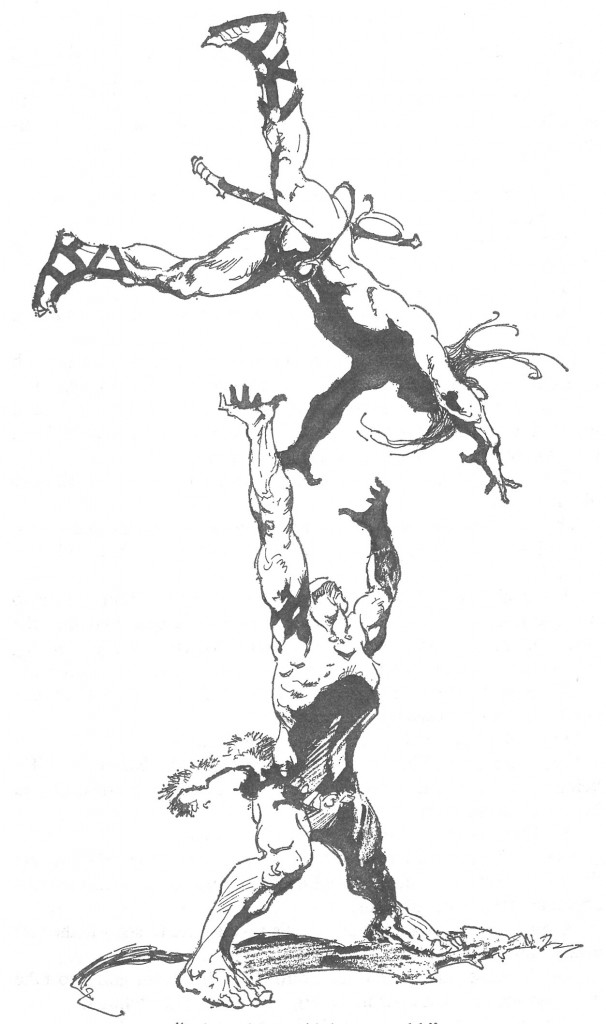 he green men of Mars have gotten scant attention since the John Carter Trilogy, so the appearance, however late, of a green man ally among the prisoners on the ship from Amhor is welcome.
he green men of Mars have gotten scant attention since the John Carter Trilogy, so the appearance, however late, of a green man ally among the prisoners on the ship from Amhor is welcome.
There is plenty that Synthetic Men of Mars appears to do right. But appearances, and especially openings, can be deceiving. The first chapters will lull readers into thinking, “Hey, this isn’t so bad. It’s not as good as A Fighting Man of Mars, but it’s showing promise. At least it will be at the level of Swords of Mars.” Weird science, flashes of horror, and the intriguing idea of the hero trapped in a monstrous body.
But then, at the one-third mark…
The Negatives
Edgar Rice Burroughs’s track record with Barsoom is a marvel. Not a one of the first eight books was of less than above average. The Master Mind of Mars and Swords of Mars are lowest on the scale, but neither is a “bad” book. And The Gods of Mars is untouchable. So I am thankful for that: a prodigious feat of sustained quality.
Now it ends. After that one-third milepost, Synthetic Men of Mars frays apart into an ugly mess, like something Ras Thavas cooked up in a vat in five rushed minutes. It’s also a boring mess. The book never recovers to cobble the pieces into something entertaining. It’s a downhill ride with an exponentially increasing grade.
The trouble begins with the “War of the Jeds,” when Ay-mad abruptly seizes control of Morbus and sidetracks Vor Daj from his escape mission. The momentum starts to fizzle as ERB throws together a plot that seems like he’s making it up as he goes: protect Janai, find John Carter, find Vor Daj’s body, find a way to get his brain back in the body, stop the mass in Vat Room 4, defeat Ay-mad from his vague threat to invade Phundahl, and … hey, wasn’t there something mentioned in the first chapter about rescuing Dejah Thoris from an injury?
Myriad motivations for the characters fly through the air, yet our heroes seem oblivious to them. They’ll pluck one out of the ether, worry about it for a moment, then toss it back up and select another problem that they won’t deal with either. You would think the threat of a synthetic army attacking all the cities of Mars, or a hideous blob-thing engulfing the planet, might get the heroes engaged. But they only get motivated for short stretches. Most of the time, Vor Daj is fretting back whether Janai likes him or not, junior high school fashion.
What’s astonishing is how little happens, considering how much appears to be happening. Instead of swinging into action, Vor Daj waits for things to happen to him. Why didn’t he volunteer to go with John Carter and Ras Thavas across the marshes? Sounds like a good adventuring time. But no, he has to go back into Morbus and do office work or something, and he doesn’t even consider that he might, oh, try to do something about the globe-threatening flesh monster! The off-hand way the characters treat this grotesque planet-crushing menace makes it feel as if they’d all prefer to ignore it, like a crazy uncle locked in the attic. Vor Daj forgets about it for a few chapters, instead cycling through the other events that aren’t advancing the story, before he recalls that there’s an overall threat.
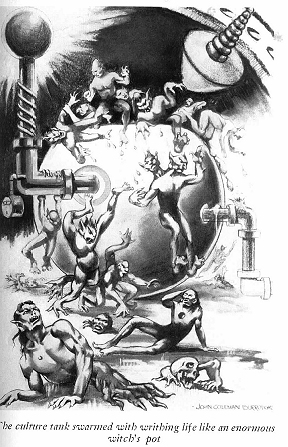 Ah, but Vor Daj is just so darn busy with his routine escaping from Morbus, returning to Morbus, losing Janai, finding her, leaving Morbus, returning to Morbus… on and on. Nothing happens, and there’s so much of it!
Ah, but Vor Daj is just so darn busy with his routine escaping from Morbus, returning to Morbus, losing Janai, finding her, leaving Morbus, returning to Morbus… on and on. Nothing happens, and there’s so much of it!
Burroughs perfected a specific kind of dialogue scene in this book: circular, irrelevant, pointless conversations. The novel swims in these, occasionally turning hilarious/frustrating. Chapter Seventeen is almost an absurdist masterpiece as Vor Daj tries to explain his plan to the lab assistants, which devolves rapidly into a round robin of “What?” “Huh?” “Come again?” “I don’t get it.” I’m paraphrasing, but this is what it feels like.
The worst of these conversations fall between Vor Daj and Janai. I gave Burroughs points for coming up with a good obstacle between the lovers. I won’t give him any points for the execution, which is a meaningless back of forth of “Do you think so-and-so likes me?” “Of course! He told me so!” “But he can’t!”, interrupted with chunky paragraphs of Vor Daj making weak excuses for why he doesn’t simply tell Janai that his brain is in a different body. Janai sees people with transplanted brains all around her; of course she’ll believe the same has happened to him. Yet Vor Daj keeps the ruse running long past reader tolerance.
This ties into another crippling problem: Vor Daj is the worst protagonist yet on Barsoom. There’s nothing special about him. He’s not a braggart or a man of action, nor does he have the rooting interest of a lower-ranking character who has something to prove. He drops into the action at the start and gets crowned the main character. Most of the time he doesn’t rescue Janai; she pops up safe somewhere. Vor Daj spends his free time wondering if Janai is safe and grumbling with self-doubt. Having the body of a hormad only gets used early on, when Vor Daj revels in the massive strength of the synthetic flesh; after that, it seems that he forgets his great prowess, and he rarely gets involved in any action again. He sums up his attitude succinctly near the conclusion: “I did not resist, for I no longer cared.” Not the mindset I want from an ERB hero.
The “kangaroo people” of Gooli might have worked in an earlier Mars novel, when Burroughs was closer to the top of his game. Now, they only emerge as random distraction to prevent the characters from focusing on a goal. They’re a cowardly and lazy race and pose no danger to Vor Daj, so they can’t even serve the purpose of excitement or danger.
It’s about the point where when the Ghoolians show up that Synthetic Men of Mars signals that it’s done. No urgency remains. Janai and Vor Daj spend weeks building a boat to cross the marshes! The reader will realize that things simply cannot improve after this. Too many plot bridges burned — or ignored — and the story has never moved from this island in a swamp. No Martian novel is more claustrophobic, especially considering it follows a book where John Carter flew to one of the planet’s moons.
The last chapters make a tardy attempt to broaden the story through Janai’s briefly mentioned backstory in her home city of Amhor. Nothing about this is established or built up, and so it feels like an invasion from another story. (For all I know, it might be.) Vor Daj gets locked in a zoo exhibit because of his freakishness, which means all the political intrigue happens outside his influence. The hormad/flesh-blob threat is ancient history when the story gets to this point, and after Vor Daj and his hastily introduced allies finally break out to run (or stroll, or whatever) to Janai’s rescue, the writing is so perfunctory that ERB’s own boredom is obvious. And the final destruction of the flesh blob is mechanical and reads like an endnote.
Why is John Carter in this story at all? He should only pop in as a cameo, because he achieves nothing that Vor Daj couldn’t as the sole hero. It isn’t as if Dejah Thoris is an important part of the story, since she’s already injured and off stage before the action starts. The prologue chapter is almost insulting in how it ditches her to the sidelines, and nobody cares about her condition. Carter and Dejah Thoris beg to get sliced right out of the book, since both are mere devices. Considering Carter’s astonishing one-man army capabilities, he could have handled the trouble in Morbus in roughly half a day.
The Synthetic Men of Mars proves that all the strange ideas a writer can muster will still bore the reader if they don’t fit inside a story with any direction or interesting characters.
Craziest Bit of Burroughsian Writing: “We were all together again, my body, my blood, and my brains…”
Best Moment of Heroic Arrogance: Vor Daj is too boring for that.
Times a “Princess” (Female Lead) Gets Kidnapped: I have no idea, since Janai seems to randomly drift in and out of captivity.
Best Creature: The Mass in Vat Room 4.
Most Imaginative Idea: The hormads
Why ERB Moved to Hawaii: “John Carter has told me of the din of Earthly cities and the brasses and the drums and the cymbals of Earthly music, of the constant, senseless chatter of millions of voices saying nothing. I believe that such as these would drive Martians insane.”
Should ERB Have Continued the Series? Nope.
Next: Llana of Gathol
Ryan Harvey is one of the original bloggers for Black Gate, starting in 2008. He received the Writers of the Future Award for his short story “An Acolyte of Black Spires,” and his stories “The Sorrowless Thief” and “Stand at Dubun-Geb” are available in Black Gate online fiction. A further Ahn-Tarqa adventure, “Farewell to Tyrn”, is currently available as an e-book. Ryan lives in Los Angeles, California. Occasionally, people ask him to talk about Edgar Rice Burroughs or Godzilla in interviews.
Sometimes I wish my obsessive-compulsiveness would relax enough to let me stop at Swords of Mars.